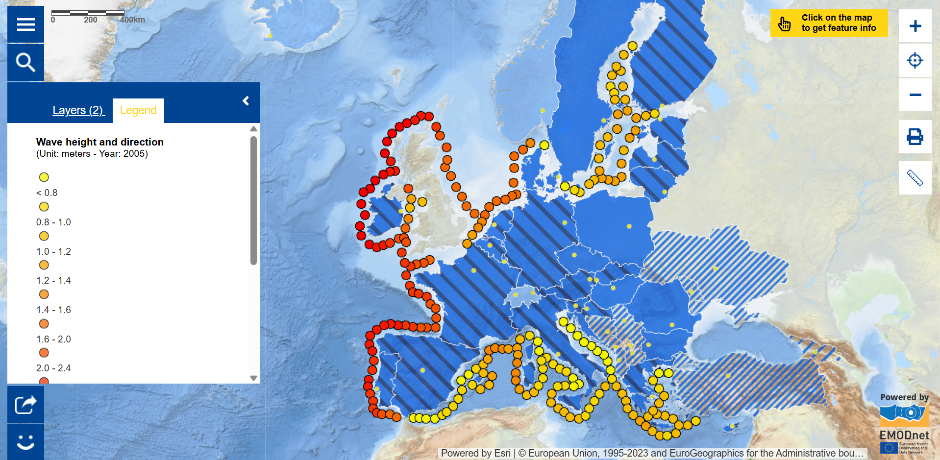
Europe has many wonderful beaches for swimming as you discovered in last week's Map of the Week on the State of Bathing Water, but did you know Europe also has great beaches for surfing? Depending on the location and timing, there are surf spots for every level, from beginner to experienced!
Speaking of waves, have you already seen the map layer in the European Atlas of the Seas that shows average wave height and direction provided by the Eurosion project – a European initiative for sustainable coastal erosion management?
Wondering how waves are formed? Let’s start with the different types of waves out there. Surface waves are formed by the wind blowing over the surface of the water. Waves formed by extreme weather such as hurricanes are known as storm surges. Tsunamis on the other hand result from underwater disturbances like earthquakes, landslides or volcanic eruptions. And lastly, Tidal waves or tides are caused by the gravitational pull of the sun and the moon.
Surface waves, loved by surfers, are formed out in the ocean in low-pressure areas. [1] When wind blows over these areas, the drag of the moving air on the water surface pulls on the water and transfers its energy to create ripples. How much energy is transferred to the wave depends on three things: the speed of the wind, how long the wind has been blowing, and the fetch – the uninterrupted distance over which wind travels. [2] So, waves are actually energy passing through the water causing water particles to move in a circular motion, rather than water being displaced. [3]
When the waves move away from the area they are generated, they become more consistent and are known as “swell”. [4] As the swell makes its way through the ocean, it is affected by variances in the seafloor. Bathymetry, the study of the ocean floor is important here. When waves travel with little obstacles, they tend to reach the shore with stronger force. [1]
Arriving at shallower waters at the coast, the deepest water molecules, set into circular motion by the waves, touch the seafloor and are slowed down by friction. While the wave grows higher, the bottom part is slowed down and the upper part rushes ahead, leaning forward until it tops over and the wave breaks. [5]
At sandy beaches, sandbanks are always changing and so are the wave peaks – where surfers want to be! Have a look at how waves are formed in the video by Surf Life Saving Australia or a more detailed one by Geography Juice.
Want to go surfing soon? Surfline provides global surf forecasts and live cams! As for swimming, always check the local conditions and guidelines. Surfrider Foundation aims to safeguard, protect and enhance the ocean. Check out their work to discover how surfers are advocating for a healthy ocean!
This week was marked by extreme heat in some parts of Europe. For example, AEMET - Agencia Estatal de Meteorología recorded a temperature of 46.0°C in southern Spain. Portugal, Italy and Greece have also been gripped by intense heat. Meteo-France has issued a top-level red (danger to life) alert for 1 and 2 July for 16 departments and 68 departments have an amber alert, with widespread temperatures above 40°C. France had its hottest June day on record on 30 June. [6]
Be careful of the hot weather if you go surfing. Here a few recommendations for surfing in hot weather [7]:
- Stay hydrated;
- Protect your skin with sunscreen and don’t forget to reapply every few hours;
- Wear sun protective surfgear that has a lightweight and breathable fabric with Ultraviolet Protection Factor (UPF);
- Time your session based not only on surf conditions but also sun exposure. Early mornings and late afternoons are great for comfortable conditions and less sun exposure;
- If the heat becomes unbearable, you may want to pause your surf session and seek shelter from the sun.
And make sure you surf safely.
The Map of the Week will be on a summer break in the coming four weeks. We will be back with new ocean and seas updates on 8 August 2025!
The data in the map is provided by Eurosion.
[1] https://www.surfertoday.com/surfing/how-is-a-wave-formed-understanding-swell-and-surf-forecasts
[2] https://www.youtube.com/watch?v=asGzaqRYm5Q
[3] https://oceanexplorer.noaa.gov/facts/waves.html
[4] https://www.encyclopedie-environnement.org/en/water/waves-swells/ [5]https://oceanexplorer.noaa.gov/edu/learning/9_ocean_waves/activities/breaking_waves.html#:~:text=When%20the%20water%20depth%20decreases,and%20breaks%20on%20the%20shore.
[6] https://wmo.int/media/news/extreme-heat-grips-europe
